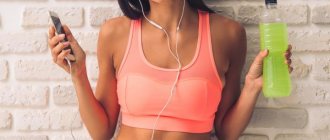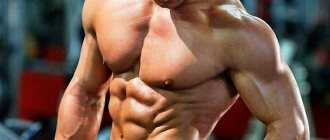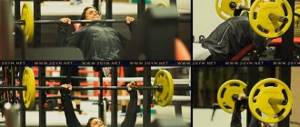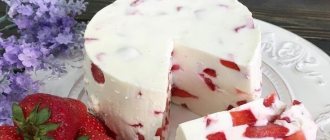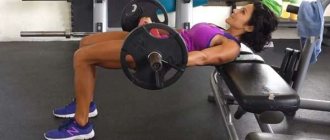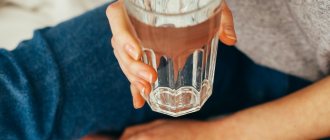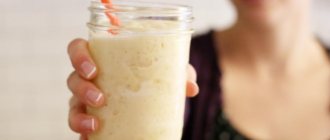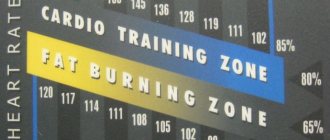Making isotonic drinks yourself at home.
Ready-made sports isotonic drinks are easy to buy in sports stores, but it is not much more difficult, but much cheaper, to prepare an isotonic drink yourself.
In addition, you will know exactly its composition, that the drink does not contain flavorings, flavoring additives and other unnecessary chemicals. Preparing isotonic water is really simple; no special equipment or special ingredients are required. Anyone can repeat our recipes and prepare isotonic water at home. Here are a few recipes (from simple to complex) that will significantly save your funds and help maintain water balance in the body.
Recipe No. 1. Simplest.
Mix 500 ml of any natural juice with 500 ml of mineral water (not carbonated).
Recipe No. 2.
- 200 ml fruit concentrate (natural);
- 800 ml of clean water;
- a pinch of salt, it is better if the salt is iodized;
- 20 grams of sugar, can be replaced with honey
Mix all ingredients thoroughly. It is advisable to cool the drink.
Recipe No. 3. The most complex and advanced.
- 3 liters of clean drinking water;
- glucose 75 grams;
- Sugar 74g. (this is approximately 16 level teaspoons);
- Maltodextrin 62g. (about 30 level teaspoons, but this is very arbitrary, with a large error.
- Salt 3g.
The ingredients can be found in pharmacies, especially those that prepare their own prescriptions. It is better to measure maltodextrin using scales; without them it is quite problematic due to the consistency of starch. In addition, it dissolves much worse than the other components of the drink, so you need to mix more thoroughly, or teeth grinding is guaranteed.
Do you have anything to add? Write comments, let's discuss.
Do-it-yourself isotonic - recipes
Drinks to maintain water-salt balance have only recently appeared on the market, but have already gained the attention of aerobic exercise enthusiasts. There are several recipes that allow you to prepare isotonic water at home:
Recipe No. 1
For preparation you will need 20 g of sugar or honey, 30 ml. any citrus juice - freshly squeezed, as well as a little salt and 400 ml. water. The liquid is preheated slightly to room temperature, sugar or honey is added and dissolved well. Then add salt to the isotonic and slowly pour in citrus juice.
Recipe No. 2
The second recipe will require saline solution - it can be purchased at the pharmacy. You also need 400 grams of glucose, two lemons, 2 tsp. sugar and 200 ml. water.
There are no difficulties in preparation: sugar is added to warm water, glucose and saline are poured in, and at the end the juice of two lemons is added. Instead of lemon juice, you can put it in an isotonic water bottle, after cutting it into slices.
Recipe No. 3
The third recipe has the function of an energy drink - it contains caffeine and will give you a little energy during sports. You will need three tea bags, vitamin C tablets - about 20 pieces and half a liter of water.
First you need to brew strong tea and let it cool. Pour water into the tea and add vitamin tablets. If desired, you can add 10 grams of glucose. Pour the solution into a bottle and place in the freezer for a couple of hours.
Recipe No. 4
A professional recipe involves adding to the drink those very ionic compounds necessary to maintain water-salt balance.
For 3 liters you need to take 2 g of sodium bicarbonate, 10 g of potassium chloride, 10 tbsp. sugar, 25 g glucose, 1.5 g magnesium sulfate. All components are mixed and used during training.
Recipe No. 5
Self-made isotonic drinks can be stored in the refrigerator for several days according to their ingredients. For example, a mixture that uses electrolytic components can be taken with you on trips. Natural formulations are more useful, but they do not last long.
General information about isotonics
First you need to figure out what it is. Like any type of sports nutrition, isotonic is aimed at improving a person’s performance and endurance during heavy loads. Its main task is to help restore the previous balance of microelements in the body that was before the workout.
When an athlete works out hard, a lot of water and salts come out of him along with sweat. Important substances such as electrolytes (elements that are indispensable in the process of transmitting electrical impulses in nerve and muscle cells) are also lost.
Their deficiency in the body can lead to spasms or convulsions. Most often, electrolytes are found in ordinary food. But why not eat in the middle of a workout? This is where isotonic comes to the rescue.
It contains those substances that the body loses during exercise. The most important component is water or other liquid. It also includes some vitamins and minerals. In the store it is sold in the form of regular soda or cans of dry powder, which must be diluted according to the instructions.
Depending on what effect is needed, there are different isotonics. They differ from each other in the substances dissolved in them. The following types are distinguished:
- Isotonic . They are in great demand in the sports nutrition market due to the fact that they are well absorbed. A special composition helps him in this, in which the concentration of salts and minerals is similar to the human body.
- Hypotonic . It is a solution that contains a minimum amount of fast carbohydrates and salts. They are used by those who do not need additional nutrition during sports.
- Hypertensive . They contain a high content of salts and carbohydrates. They replenish nutrients and electrolytes.
What is isotonic
Isotonic is a sports drink necessary to restore the balance of fluid and electrolytes in the body during physical activity and cardio training. The isotonic drink contains carbohydrates (maltodextrin, fructose, glucose) and mineral salts (magnesium, potassium and sodium chlorides). Some manufacturers also add caffeine and vitamin complexes.
The main advantage of isotonic water for runners is its ability to quench thirst better than regular drinking water. In addition to replacing fluid loss, isotonic drinks help replenish the loss of minerals caused by increased sweating, and are also a source of quick energy and increase glycogen reserves in the body.
Note that sports drinks are recommended for physical training lasting more than 60 minutes. BCAA amino acids will help with strength training, and isotonic acids will be useful for cardio endurance training - especially in the case of long runs in hot and sunny weather. However, for workouts shorter than 45 minutes, isotonics will not provide additional benefit.
Types of isotonics
Sports isotonics are sold both in finished form (that is, liquid in a bottle) and in the form of dry concentrates for mixing with water. Often, buying isotonic powder or tablets is more economical. In addition, you can prepare an isotonic drink at home entirely with your own hands - in this case, you can control the amount of minerals and carbohydrates.
Note that ready-made isotonic drinks such as Powerade and Gatorade contain a significant amount of maltodextrin. Such carbohydrates have a high glycemic index and instantly increase insulin levels in the blood. Although it helps athletes train more energetically, it is not recommended for fat loss training.
Isotonics
Sports drinks for increasing speed and improving the quality of recovery of the body after training are called isotonics. The composition of such cocktails includes five main components - salt, water, sugar, minerals, vitamins. Isotonic drinks are not full of sugar and salt. The concentration of substances in the drink does not exceed the content of these elements in the human body. These supplements can be bought ready-made, but there are proven recipes that allow you to prepare homemade isotonic.
Prolonged intense exercise always results in sweat, along with which the body loses the most important and valuable micronutrients, minerals, and vitamins, which becomes the main cause of loss of stamina and motivation, as well as fatigue and general loss of strength. Isotonics help athletes make the training process more effective and productive, increase the limit of endurance, and recover much faster after long and grueling exercises. Athletes, as a rule, drink isotonic drinks when they perform training that requires maximum dedication - an expenditure of enormous effort. Drinks are useful not only during strength training, but also during aerobic training.
Composition of isotonics
The carbohydrates that the body receives from drinking isotonic drink are contained in the drink in the form of regular sugar. Its amount is most often about 5-8%. This is quite enough to replenish energy reserves. Along with carbohydrates, the drink must contain calcium, magnesium and potassium. Some components of the product are variable and depend on the manufacturer.
Supplements may contain amino acids, various minerals, and vitamins. Most isotonic drinks contain L-carnitine, which not only makes the athlete more resilient, but also activates lipolysis - fat burning. Among such products we can note Mineral Booster, produced by Power System. The company also produces another popular isotonic drink called “Isotonic Energy Drink”. This product, by the way, is one of the most popular and popular among other analogues.
Research on isotonics
The effect of the sports supplement was studied by Scottish scientists. The participants in the focus group were teenagers, and the results showed that young people taking the drink increased their endurance levels by 24%, meaning they were able to exercise much longer and, therefore, more productively. This experiment proved the effectiveness of the drink. In relation to this study, we took an isotonic drink, consisting of 6% carbohydrates, sugar and electrolytes.
Not all scientists have a positive attitude towards this kind of energy sources. There are also those who consider isotonics completely ineffective. Salt can have a negative impact on your health, which, as Australian scientists have found, can provoke the development of various gastrointestinal problems and even seizures. Another argument skeptics cite is the lack of an extensive scientific evidence base, since there are not very many studies on the effect of isotonics on training performance.
The lack of a clear opinion regarding the sports drink did not affect the popularity of this type of supplement. High demand and reviews from athletes indicate that they are quite effective. Isotonic drinks, as noted by athletes, increase endurance and provide higher motivation and concentration during training. It should be noted that it is most advisable to take the drink during the mass gain stage or when performing endurance exercises. Athletes who want to lose the maximum amount of body fat are better off giving preference to regular drinking water, which does not contain sugar and calories, since isotonic drinks contain both.
How to make a universal isotonic at home
- Add 3 teaspoons of green tea to 500 ml of warm water. The temperature should not exceed 60°C, since above this temperature the tea will lose a significant part of its nutritional and energy properties.
- After brewing the tea, let it cool for a few minutes, then add acacia honey and agave syrup.
- Add 1 gram of baking soda.
Why these ingredients?
- Green tea is an effective and natural antioxidant that allows you to systematically eliminate acids caused by muscle activity. It also contains theine, which is a good natural energy stimulant and is easier to digest than caffeine.
- Acacia honey is the best sports honey. It is faster and easier for the body to absorb than flower honeys. Its main purpose is to effectively combat asthenia, therefore it is preferable in the fight against fatigue.
- Agave syrup is often used in sporting goods recipes. Thanks to its low glycemic index, the carbohydrates contained in this syrup allow it to be converted into liquid sugar. A practical property for endurance.
- Sodium bicarbonate helps offset losses associated with sweating due to its mineral salt form. By taking soda, you can avoid cramps and pain. And the main reason for its frequent use by athletes is its ability to easily neutralize the acid that accumulates in the muscles during training.
Is it possible to do it yourself
Isotonic can be prepared at home. A homemade isotonic will save your budget and protect you from harmful chemical additives that are present in some purchased products.
How to make a basic isotonic with your own hands:
- a pinch of salt;
- 100 ml water;
- 100 ml fruit juice or fresh juice.
All components are mixed in a 0.5 liter shaker. A basic drink made in this way helps regulate the metabolic processes of water and salts in the body. Homemade lemonade with a pinch of salt also works as a post-workout energy booster.
How to prepare powdered isotonic:
- packaging of ascorbic acid (vitamin C);
- rehydron (15 g);
- fructose or powdered sugar – 100 g;
- flavoring
The listed ingredients are mixed and shaken in a storage vessel. This mixture is diluted in 10 liters of water.
Berry isotonic recipe:
- 150 g cranberries (currants, blackberries or raspberries to choose from);
- 80 g sugar;
- 1 tsp salt;
- 600 ml water.
To prepare the drink, you need to take fresh or frozen berries, put them in a deep bowl and crush them. Squeeze the berry juice using a fine sieve and pour into a cup. Pour water over the berry skins, bring to a boil and simmer for several minutes. The boiled peel needs to be strained, and the juice should be poured into the broth and sugar should be added.
Vegetable isotonic:
- 1 liter of freshly squeezed vegetable juice (beetroot or carrot);
- 300 ml of drinking water;
- a cup of orange or grapefruit juice;
- a pinch of salt;
- honey or sugar to taste.
There are many variations of recipes with "improved" and more expensive ingredients. You can try options with a variety of juices, fruits, vegetables and berries to which you are not allergic.
Admission rules
It’s not enough to make an isotonic drink at home, you still need to learn how to take it correctly.
This drink should not be perceived as just a universal thirst quencher. It must be drunk according to a strict schedule. It is in this case that it will provide maximum benefit to your body - believe the portal hudeem-bez-problem.ru.
If you are actively involved in sports, then do this:
- 30 minutes before training, drink a little isotonic drink, made with your own hands or purchased,
- during an intense workout, take 2-3 sips literally, at equal time intervals - this should be done even if you have no desire to drink at all - after all, you do not need to quench your thirst, but to replenish the lost supply of electrolytes,
- Save the last portion of the drink for the moment immediately after training.
Is it worth taking energy drinks?
Most energy drinks, unlike isotonic drinks, are oversaturated with caffeine and carbohydrates. As you know, caffeine is quickly addictive, and frequent use of energy drinks has a bad effect on the functioning of the cardiovascular system. In addition, caffeine excites the nervous system. For those who go cycling to relax and de-stress, this may not be exactly what they need.
The only exception is fans of multi-day cycling trips or participants in cycling marathons. They need caffeine simply to avoid falling asleep while driving a bike. In terms of healthy lifestyle, these people are “beyond good and evil” and definitely do not experience problems with the heart and blood vessels, since they decide to go on long rides. So for them, energy drinks are a completely reasonable alternative to hearty, but not always compact, snacks, and sometimes a vital boost of energy.
Isotonic recipesedit edit code
Main article:
homemade energy drink recipes.
The following recipes are translated from various Western sites.
"Sports Academy"
- 500 ml natural fruit juice (orange, apple, pineapple)
- 500 ml water
- Mix ingredients and cool
"Your isotonic"
- 50-70 g sugar
- liter of warm water
- a pinch of salt
- 200 ml natural fruit concentrate
- stir and cool
"Fruit Academy"
200 ml natural fruit concentrate 800 ml water pinch of salt mix ingredients and cool
"A drink similar to Gatorade"
- Take a container (plastic bottle) with a volume of 600 ml.
- Add 3 tablespoons of sugar and 1/8 teaspoon of salt (about 2 pinches) to the bottle. This will be the base of the drink - a 6% carbohydrate solution containing about 100 mg of sodium (the famous Gatorade drink has a similar composition). In addition, you should add 200 ml of natural fruit juice and 400 ml of water.
"Gleesonade"
- 50 g glucose (dextrose monohydrate)
- 0.5 g table salt (sodium chloride)
- 1.5 g baking soda (sodium bicarbonate).
- Dissolve all of the listed ingredients in 500 ml of water and mix thoroughly.
Note
.
Table salt (sodium chloride) can be replaced with sodium citrate (sodium citric acid), and the drink will acquire a slightly different, sour-salty taste.
The drink can be prepared in dry form and diluted with water if necessary. To do this, instead of liquid juice concentrate, you can use dry juice (or use instant fruit drinks).
"Hypotonic"
100 ml orange juice concentrate, 1 liter of water and a pinch of salt (1 g). Mix the ingredients and cool.
Hypertonic drinksedit | edit code
Recipe 1
400 ml concentrated orange juice, 1 liter of water and a pinch of salt (1 g). Mix all ingredients and cool.
Recipe 2
- a glass of orange juice
- 2 tablespoons lemon juice
- 1 tablespoon lime juice
- ¾ teaspoon salt
- water
Recipe 3
- 10 teaspoons sugar (120 g)
- 3/4 teaspoon salt (4.2 g)
- 50 ml fruit concentrate for taste and aroma
- add all ingredients to 2 liters of water
- Thus, at the end we get a drink with a carbohydrate concentration of 6.2%. One glass of drink (250 ml) will contain about 15 g of carbohydrates (6%), 105 mg of sodium, 125 mg of potassium. The energy value of 250 ml of the drink will be approximately 55 kcal.
Note. Sugar can be replaced with honey if desired.
Isotonic recipes
There are several simple options that you can do yourself. Each recipe suits specific needs.
Simple
For it you will need:
- 20 grams of honey;
- 2 tablespoons unsweetened juice (grapefruit, lemon);
- a pinch of salt;
- 2 glasses of warm water.
All components must be mixed well. This drink is perfect for those who do not engage in grueling workouts. It is good to use it before jogging.
Energy
For it you will need:
- 3 tea bags;
- half a liter of water;
- 2 teaspoons sugar;
- 3-4 tablets of ascorbic acid.
Tea is poured with boiling water. It should be allowed to cool to room temperature. Crush ascorbic acid tablets in a mortar and add to tea along with sugar. This isotonic drink contains a minimal amount of carbohydrates. Therefore, it is advisable to drink it for those who want to lose excess weight.
Complex
For it you will need:
- 3 liters of water;
- 11 tablespoons of sugar;
- 2 grams of sodium bicarbonate;
- a teaspoon of potassium chloride;
- 1 milliliter of magnesium sulfate.
All these substances can be obtained at the pharmacy. You can mix in any order. This isotonic drink contains a lot of glucose and electrolytes. Perfect for bodybuilders doing strength training.
Which isotonic drink is better
In order to answer this question, you need to approach it from an unusual angle. At the beginning of the article, we completely analyzed the composition of a typical isotonic drink, then we gave a rating of isotonic drinks, and from this amount of information it becomes clear to us that there are virtually no significant differences in the composition of the additives. And the insignificant differences relate only to their form of release. There are several forms of release of isotonics. These are isotonics in the form of a ready-made drink, isotonics in tablets, isotonics in powder and isotonic gels. The difference here lies, by and large, only in the method of preparation and use. It cannot be said that powder is better than tablets, tablets are better than gel, or, for example, that a gel is better absorbed than a ready-made drink. The difference in shape is only in convenience.
Okay, but what recommendations should you follow in this case? In this case, the following approach should be followed. The best isotonic drink is the one that works best for you. There is such a term as “individual susceptibility” or immunity to the components of the supplement. Each person has his own level of receptor development, his own level of perception, his own metabolic characteristics, including his own stimulants of allergic reactions. Thus, in order to understand which isotonic is best for you, the only sure way is to try several different ones and evaluate your sensations. It is even possible that the best effect will be provided to you not by a purchased isotonic at all, but by one that you have made yourself.
Which hikes require isotonic drinks?
Before these substances became so widespread in sports, rehydron was sometimes taken on a hike. The drug from the pharmacy helped with poisoning and intestinal disorders. The action is based on the restoration of water and electrolyte balance due to the presence of mineral salts and dextrose in the composition. Sports isotonics act almost similarly. The only difference is the taste and some additives. Modern drinks are pleasant to drink, unlike rehydron, and they also additionally contain vitamins, caffeine or other substances.
On simple hikes, isotonic drinks are not at all necessary. With a well-thought-out route without overload and with a full menu, the electrolyte balance remains in order. However, on some expeditions such a drink will quench your thirst and restore strength.
— Long hikes and climbs, including in winter. They are characterized by electrolyte imbalance due to the lack of minerals in mountain and melt water. At the same time, energy deficiency sometimes appears. Isotonic diversifies the diet with new tastes.
- Long bike rides. If possible, their participants replenish their salt reserves with mineral water, but isotonic water is lighter and tastier.
— Short, high-intensity exercise. This category includes, for example, fast ascents, multi-races, forced marches. A lot of energy is spent on such adventures, and it will not be possible to replenish it with food or rest.
Isotonic at home
The key ingredient for making isotonic water at home is regular table salt (or Himalayan salt)
The second most important component of the composition are simple carbohydrates (honey, sugar, fruit juice). A properly prepared isotonic drink should have a sweet-salty taste, which can be improved with the usual mint, ginger and lemon, as well as coconut water, honey or even fennel seeds.
Ingredients for homemade isotonic:
- 500 ml water
- 500 ml fruit juice
- 1-1.2 g salt
- mint, ginger and lemon to taste
Isotonic with rehydron
Regidron is a dietary supplement sold in pharmacies without a prescription. Contains dextrose, sodium chloride, potassium chloride and sodium citrate dihydrate. In fact, rehydron is a mixture of mineral salts and carbohydrates, being a simple isotonic powder. A third of a teaspoon of the drug is diluted per liter of water - a sachet (19 g) is enough to make 12 liters of isotonic.
After rehydron is diluted in water, sources of carbohydrates and flavoring additives are added to it. The amount of carbohydrates depends on the type of physical activity. The usual dose is 10 g (about 2 teaspoons) per liter, but with prolonged high-intensity training, the figure can reach 50-70 g of carbohydrates per liter. Their source can be either maltodextrin powder, honey or juice.
Energy drink
Recipes for homemade isotonics often include energy components - that is, caffeine in various variations. The source of caffeine can be either strong brewed tea or instant coffee, or caffeine tablets (sodium benzoate). In most cases, synthetic caffeine is more convenient, since it does not have an aggressive effect on the stomach - unlike strong tea.
However, let us recall that caffeine has both a number of advantages (primarily, it increases focus and enhances performance) and a number of undesirable disadvantages. In addition to the fact that caffeine is a fairly strong diuretic and increases sweating, it can increase heart rate, which may be undesirable for some athletes. In this case, the source of caffeine is not of fundamental importance.
***
Isotonic drinks are sports drinks containing electrolyte salts and fast carbohydrates. The main benefit of taking an isotonic drink is to restore the balance of minerals in the body and suppress the processes of water loss. You can make an isotonic drink at home by adding regular table salt and sources of carbohydrates (honey, fruit juice) to the water.
- Effects of an isotonic beverage on autonomic regulation during and after exercise, source
- The Effect of Drinking Water and Isotonic Sports Drinks in Elite Wrestlers, source
Material rating:
Sports isotonics - pros and cons. How to prepare isotonic at home?,
5 / 2
You need to enable JavaScript to vote
How to make your own isotonic drink. Homemade sports drink
Nutrition
Do you remember when you were a child, in biology lessons, the teacher showed an experiment with onion skins?
At first we simply looked at the drug under a microscope, observing the cells, and then we added a drop of liquid with a high salt content.
And we observed the separation of the cell contents from the cell wall; the cell seemed to “shrink.”
When we got a little older, in anatomy class we were told how important it is to use saline solution rather than ordinary purified water when administering medications, so that blood cell destruction does not occur.
For any living organism it is very important to maintain the constancy and integrity of the internal environment. And this happens due to the fact that any living cell is an open system and constantly interacts with the environment.
Now let's remember the phenomenon of osmosis. It plays an important role in many chemical and biological systems.
Thanks to osmosis, the flow of water into cells and intercellular structures is regulated and thus the constancy of the internal environment is maintained. Solutions that have the same osmotic pressure are called isotonic. That's what we'll talk about.
Fashion for healthy lifestyle. Food fashion
A huge number of sports centers and many non-professional competitions contribute to the rapid growth in the popularity of running, swimming and other sports.
Along with this, the sports nutrition industry is also developing. More recently, so-called isotonic sports drinks have become very popular.
What is it and what do you eat it with, or rather drink it with? A sports isotonic is a drink that contains a mixture of carbohydrates, salt, and minerals in a certain concentration.
It helps replenish fluid loss during intense physical activity. What is its difference and advantage over conventional liquids?
Isotonic and water-electrolyte balance
During high physical activity, a person loses a lot of fluid, as body temperature rises and, as a result, more intense sweating occurs.
And this, in turn, leads to loss of physical performance, and in some cases can pose a danger to life and health.
During exercise, the body loses not only fluid, but also minerals and salts dissolved in it, which are electrolytes (i.e. substances that conduct electrical current).
Without them, the human body would not be able to perform muscle contractions, produce energy, enzymes, hormones and vitamins.
Electrolytes, unlike proteins, fats and carbohydrates, are not direct sources of energy, but play a vital role in maintaining a constant internal environment.
The optimal solution for replenishing water and electrolyte balance is to drink isotonic drinks, which not only prevent dehydration, but also eliminate mineral imbalances, unlike non-isotonic drinks or water.
Thus, the main function of an isotonic drink is to maintain balance in the athlete’s body.
3 simple ways to make isotonic water yourself
The main attention is paid to the content and especially the concentration of carbohydrates and minerals. It is the concentration of the constituent components of an isotonic that characterizes its compliance with the composition of the blood plasma.
An important factor that people pay attention to is the taste component. After all, not everyone will agree to take rehydron (a drug used to eliminate dehydration in medicine).
Sweet and salty taste is not for everyone. Manufacturers add various fruit and berry fillers to give energy properties to the product and improve taste.
You can prepare isotonic water at home, on your own, since it contains components that are accessible to everyone. This makes it cheaper and in some cases tastier than bottled analogues.
For those who like to tinker, you can find a huge number of recipes, but the main thing they all have in common is the need for precise dosage of ingredients. Let's see what we can do?!
First way. Simple
The simplest and non-steamed recipe is to mix your favorite juice and water in a 1:1 ratio and add salt (1 tablespoon per liter).
Second way. A little more complicated
Mix 20 grams of sugar (honey) and 1 gram of salt thoroughly in 50 ml of warm water. Add 30 ml of lemon juice to the resulting solution. Mix everything that comes out with 350 ml of cold water.
Third way. Semi-professional
Before we begin preparing this isotonic drink, I note that accuracy is very important in this method. Inaccurate dosage of ingredients used may have a negative impact on your health.
And so, we need: 4 percent potassium chloride - 10 ml, 2 grams of sodium bicarbonate, 25 percent magnesium sulfate - 1.5 ml, 50 grams of glucose (powder), 20 teaspoons of sugar. Dilute all this in three liters of filtered water.
Instead of isotonic. A drink that can be used instead of isotonic to restore strength is warm tea with honey.
An integrated approach to the training cycle
The English Channel is treacherous. Not everyone who tried to swim across it obeyed. At the beginning of the last century, there were only a few who swam across the strait separating the mainland from the island part; they were known by name.
Every year there are more and more successful starts. And now we are watching how more than 1,000 people have already swam the 32-kilometer-long English Channel.
It became clear that in order to overcome the marathon distance (not only on water!) an integrated approach to the training cycle is required: hardening, training for speed and endurance, recovery, working with a coach and improving technique.
This means that special attention began to be paid to nutrition during training, before the start, during the swim, and of course, after.
All those who have made sports a part of their lives should not forget about proper nutrition and sports nutritional supplements.
Together, they have a positive effect on the condition and functioning of the body, allowing it to cope with more intense loads, thereby increasing endurance and strength.
Sports in balance with health to everyone!
There are many recipes for making isotonic water yourself at home. We will be grateful if you share your experiences.
If you want to prepare for a half marathon, marathon or IRONMAN, then come to the RUNTOFINISH.RU school. With us you will train with an experienced coach, whose student occupies a leading position in the world triathlon rankings.
You will receive running, swimming and cycling training, cardio-strength training and a set of general physical fitness exercises.
You can also win valuable prizes in our competitions and even a whole slot (ticket to IRONMAN).
Irina Dubrovina. Faculty of Biology, St. Petersburg State University.
Since 2012, she has been passionate about open water swimming and triathlon. Source: runtofinish.ru
The concept and importance of water-salt balance
During a period of prolonged physical activity, accompanied by profuse sweating, a person loses not only fluid. Along with water, salts also come out, the level of which directly affects well-being and endurance. The loss of electrolytes - sodium, potassium, magnesium, chlorine is especially pronounced during systematic long-term training in the heat and threatens the body with dehydration and disruption of the water-salt balance.
The most detrimental effect is the loss of sodium. Hyponatremia threatens the appearance of muscle weakness and impaired neuromuscular excitability, cramps of the calf muscles, loss of taste and, as a result, aversion to food. The most severe consequences of sodium imbalance are decreased blood pressure, weakness and loss of consciousness.
Important: consuming large amounts of water does not solve the problem of salt deficiency, but only aggravates it. A liquid that does not contain sodium and other elements thins the blood, further reducing their concentration
Restoring the balance of fluids and electrolytes is what an isotonic drink is for. And we are talking not only about athletes, but in general about people whose activities are associated with prolonged, active physical activity and profuse sweating. Also, restoring the water-salt balance is necessary for those who have suffered infectious diseases accompanied by fluid loss due to high fever, vomiting or intestinal upset. In medicine, agents that restore fluid and electrolyte levels are called rehydrants.
Isotonics: benefits and harms
If at first, after isotonic drinks appeared on sale, they were used only by people involved in sports professionally, now in any gym you can see colorful bottles of isotonic drinks instead of regular water from almost every second amateur athlete.
The popularity of this drink forced doctors to take a closer look at it. Their verdict was as follows: the use of isotonics is justified only for those who experience regular increased physical activity. And such loads should last at least 90-120 minutes. If the training process takes you less than half an hour, it is not recommended to take isotonics.
The main argument of doctors against the use of these drinks was: the consumption of energy and salts during workouts lasting 45-90 minutes is not critical and is easily restored with the help of regular foods. In this case, consuming isotonic drinks can lead to slower weight loss and even weight gain.
Their second remark was that the recipes for isotonic drinks that are sold in stores, in addition to useful substances, contain a certain amount of dyes and preservatives. And this fact should stop people who are concerned about their health and leading a healthy lifestyle from purchasing them.
After such publications, many athletes really thought about how to make isotonic water with their own hands.
Isotonic recipes at home
Despite conflicting reviews about this energy drink, recently it is still popular among athletes. Many people prepare it themselves at home. Let's look at how to prepare isotonic water in some popular recipes.
Drink "Classic":
A very simple recipe for making isotonic water with your own hands, which tastes like the one sold in stores.
- Brew three black tea bags in a glass or cup.
- Then pour the infusion into a half-liter bottle.
- Add cooled boiled water to the top.
- Then pour 20 ascorbic acid tablets into the bottle.
- Shake the drink until the ascorbic acid dissolves.
- Then place the finished drink in the refrigerator.
You should drink it in small sips while performing various activities. The caffeine in tea has a tonic and stimulating effect. Ascorbic acid will help suppress catabolic hormones. This isotonic can also be used for weight loss.
Energy drink "Razdrive":
The ingredients in this energy drink can be manipulated to suit your taste.
- Make the preparation according to the above recipe.
- Pour two dozen drops of Eleutherococcus tincture into it.
- Then add 20 pre-crushed glucose tablets.
- Add 10 grams of BCAA powder.
- Stir all this and put the finished drink in the refrigerator.
You should also drink it during training.
Decaf Recipe:
This is an energy drink that you can make yourself without caffeine. It can be prepared very simply and quickly. You need to take a bottle of mineral water, preferably warm, and add two tablespoons of honey to it. Then add squeezed lemon juice (can be replaced with citric acid) and a little tincture of any adaptogen. You can use it both before and during training.
Isotonic drink for athletes:
This recipe is suitable for all athletes involved in outdoor sports, namely: running, swimming, cycling, etc. The previous recipe is taken as a basis, but replacing mineral water with rehydron, which is sold in pharmacies. It replenishes the body's potassium and sodium ions lost through sweat during exercise. It can also be used as an isotonic for weight loss.
By experimenting with ingredients you can achieve an original isotonic taste that you really like. If you don’t want to waste your time making isotonic drinks, you can buy it at any supermarket.
How to make isotonic at home: reviews from those who have tried it
- Now I don’t have the opportunity to buy isotonic drinks, because they are incredibly expensive. But I realized that without such drinks I simply fall without strength and only cause harm to my body. Basically, I made it myself. Of course, all this is quite troublesome, but at least I really have peace of mind that I’m training and at the same time restoring all the necessary substances. Karina
- The drink I made myself at home has never let me down. Of course, I can’t compare with store-bought ones because I haven’t tried them. I just looked at the prices. And I think it's not worth it. I found several recipes for myself, I do everything exactly as it is written, “according to the instructions”, everything turns out great. I just don't see the point in overpaying. Dmitriy
- You know, I honestly didn’t understand the particular buzz from this isotonic drink. Maybe it's just fashionable and that's it? I cooked. Well, yes, it turned out to be tasty water, nothing more. I added orange juice to it. Polka
- I read on one forum how to make an isotonic drink at home, made it, poured it into a special sports bottle and I walk around the gym looking cool :) Oh, and I also decided that I could decorate it with some more lemon slices, I just added a couple of them there. I’ve been taking it for a month so far, I can’t even say how much it affects the muscles, but it has affected my mood. And somehow I don’t really like drinking plain water, but with lemon juice and honey it turns out really delicious. Ninulya
Manufacturers offer various new products and products for athletes, but they are very expensive. And if you follow the recipe and proportions, you will get no worse than a DIY isotonic drink.
Author - Eva Raduga, portal about weight loss WE LOSE WEIGHT without problems!
What is included in isotonic drinks
Isotonic drinks that are currently produced contain a certain amount of salts (potassium, magnesium, sodium), glucose polymers (dextrins and maltodextrins). The concentration of carbohydrates in isotonic drinks is about 4.5%. In addition, they contain potassium and magnesium salts, various vitamins and microelements and very often various biological additives, as well as flavoring agents and aromas. All these components of the drink together create a restorative effect.
You must be careful when choosing an isotonic drink, as they do not always meet the body’s needs. Very often they use sweeteners such as saccharin and acesulfame.
These substances are similar in chemical structure and give an unpleasant taste to the drink, and they are suspected of being carcinogenic. But they continue to be used because of their low price. All drinks with saccharin or acesulfame should not be consumed regularly.
The presence of glucose in drinks is beneficial if it is used to replenish glycogen expenditure, but in this case the drink contains an insufficient amount of sugars. Glucose also causes a sharp spike in insulin due to the high glycemic index. Drinks with dextrins are most suitable for these purposes, but they also cannot provide the body with a sufficient amount of carbohydrates. Very often, fructose is used as a sweetener - it is sweeter than regular sugar and has a lower glycemic index. But not all people tolerate fructose.
When drinking isotonic drinks, side effects may occur in the form of gastrointestinal disorders. Much depends on the careful selection of the composition of the drink and the individual reaction of the body to the substances it contains.
With all their advantages, isotonic drinks cannot be a solution for all cases; they can only make life easier in some moments. It is better to cover the bulk of the body's fluid needs with mineral waters, juices and liquid dairy products.
Also read on this topic:
Maintaining the athlete's immunity. No matter how healthy and fit you are, you are still vulnerable, especially during seasonal flu epidemics. The best way to resist diseases is to help your immune system fight them. It is also necessary to support the immune system throughout the year...
Glycogen training. Typically, all athletes eat a carbohydrate-rich meal 2 to 3 hours before a race to ensure maximum glycogen reserves in the body. But if you specifically manipulate its level during training and reduce your carbohydrate intake to 33%...
Caffeine and sports. Caffeine stimulates the central nervous system. It is a legal stimulant of the human body with some restrictions. Has many other physiological effects. Present in coffee beans, tea leaves, cocoa beans, chocolate...
Lack of vitamins in athletes. During endurance exercise in athletes, vitamin C is rapidly excreted through urine. If the body is insufficiently supplied with vitamin C, performance decreases. The need for vitamin C especially increases during endurance training...
Medicinal herbs for cyclists. Many medicinal plants can speed up the body's recovery process and improve athletic performance after and during heavy physical exertion when cycling. Moreover, they have a gentler effect on the recovery process...
Composition of the drink
An isotonic drink is a balanced ratio of water, electrolytes and carbohydrates. The chemical structure may vary, but the basis of the isotonic fluid composition is prepared according to the methodology for developing oral rehydration medications.
The main components of the isotonic composition:
- vitamins;
- minerals;
- amino acids;
- fast sugars – about 8%;
- magnesium salt;
- potassium salt;
- sodium salt;
- flavor enhancers;
- chemical additives.
Manufacturers can add vitamin C, amino acids and energy elements to the structure of the drink. Specialized sports nutrition stores offer the product in powder form with a variety of tastes and smells.
Various additives in isotonic drinks are intended for specific sports:
- drink with creatine and glutamine for bodybuilders;
- L-carnitine supplement for weight loss;
- caffeine, taurine or guarana are added as an energy boost for runners.
To improve taste, isotonic drinks are supplemented with chemical ingredients: dyes, taste stabilizers and flavorings. These ingredients may cause side effects. The most common of them are individual intolerance and poor absorption of the drug.
Is isotonic necessary in sports nutrition?
When training begins, and even a long one, the athlete loses a lot of energy and nutrients from the body. It is recommended to restore strength by consuming an isotonic drink. Isotonic is considered a light, energy-restoring drink. It quenches thirst and restores energy spent during training.
No other drink can replace isotonic drink in sports. Every second athlete prefers isotonic water to regular water during and after training.
Water, like isotonic water, also contains salt, but it is not at all suitable for athletes who train for many hours. You need to drink 20 liters of ordinary water to get the required dose of salts removed from the body after one workout. Therefore, water is not what professional athletes need.
Let's take another sports product - energy drink. It, of course, enhances performance and gives strength, but it has a very strong effect on the heart, which forces it to work harder. During training, the heart already works quickly, and with an energy drink it goes even faster. And this is very harmful for humans. This is why energy drinks are also not suitable for training.
Alcohol is generally not suitable for athletes. It leads to dehydration of the body, the speed of the liver slows down and the loss of vitamins and salts increases, and motor function is weakened. So this drink is not suitable for athletes.
The benefits and harms of taking isotonics
Isotonic increases endurance, but does not affect the athlete’s strength and speed performance. In order for a sports drink to be beneficial, carbohydrates should not exceed quantitative indicators of 4-8% of the total composition. Only with such a concentration will it be absorbed and will not harm digestion.
Electrolyte solutions are especially useful in hot weather and during workouts lasting more than 1 hour.
You can use isotonic only if your water-salt balance is unstable. If a person whose water and electrolyte levels are normal begins to take the solution, health problems may arise. Salts that linger in the body will cause tissue swelling.
People with hypertension and diabetes are at greater risk. Deposited salts negatively affect the musculoskeletal system, disrupt the digestion process, and lead to cramps. Those who are trying to lose weight do not need isotonics. Glucose and its derivatives, which will increase in the blood, do not contribute to rapid weight loss.
Possible harm
Ready-made store-bought isotonics may contain preservatives, dyes, citric acid and sweeteners. Such components will definitely not benefit the athlete. Therefore, when choosing, you must carefully read the information on the label.
Since isotonic water is not absorbed as quickly as water, it should be drunk in even portions during training.
People with diabetes should not consume such sports drinks because they contain glucose.
Isotonic at home
Do-it-yourself isotonics can be made at home, but it is not recommended to resort to this, since it is difficult to calculate the dosage of useful substances that should enter the human body after training. However, there are many recipes for isotonics at home.
Isotonics. Photo: nutritiousme.com
The simplest isotonic at home is a simple recipe: Take a pinch of salt, 100 ml of freshly squeezed juice (for example, apple, orange, grapefruit), 100 ml of water.
Isotonic drink at home for running:
- ascorbic acid – 30 g;
- 15 g of dry matter intended for oral rehydration;
- fructose, stevia, powdered sugar – 100 g;
- flavoring
The initial components of the innovative isotonic drink are mixed together. Store in a dark place. The amount of starting substances is enough to make 10 liters of drink. There is another cooking option:
- water;
- minerals;
- carbohydrates.
The basis of the recipe is ordinary drinking water. Electrolytes can be obtained from a pharmaceutical preparation called Regidron. If you follow the instructions for it, you need to dilute 1 sachet per liter of water. For a sports drink, dilute one packet per 2 liters of water. If Regidron is not in your home medicine cabinet and you cannot purchase it, you can use soda. As an addition to the recipe, we take juice (orange, apple).
Do-it-yourself sports isotonic at home
It is important to know that the purpose of the drink is not only to quench your thirst. They are of particular value for runners and long-distance swimming. The athlete loses a lot of fluid through sweat. With it, substances involved in biochemical reactions in organs are washed away, the functioning of the cardiovascular system is disrupted due to an increase in blood density.
If you provide the body with the necessary substances in advance, you can avoid unpleasant consequences during training or competitions.
1. Clean, filtered water.
2. Electrolytes. Sodium, magnesium, potassium salt.
3. Carbohydrates. Sweet ingredients. Natural sugar, glucose, honey or synthetic maltodextrin, dextrose.
4. Flavoring additives, as well as vitamins, caffeine, creatine, glutamine, L creatine to increase biological activity.
Sports nutrition companies have developed the supplement in powder form. You just need to mix it with water in specified quantities. Convenient, but expensive. In addition, to extend shelf life, anti-caking components and preservatives are added to it. Therefore, many athletes prepare isotonic drinks with their own hands at home.
Drinks made at home will contain only healthy ingredients. The question of what components are required and how to make isotonic water with your own hands is not difficult.
The first and essential component is the liquid component. If water is selected, it must be clean. This is not an idle question. It is better to choose filtered or bottled. It is advisable to prepare juices yourself. Packaged juices may contain too much sugar or concentrate.
READ MORE: NOW Special Two Multi Vitamin release form composition intake price
Salt is used as the main electrolyte. Sodium and chloride ions participate in biochemical reactions that maintain water balance. Their deficiency provokes excessive loss of water in the organs. Iodized or sea salt is healthier. Good electrolytes and important chemicals - magnesium and potassium - are needed for normal biochemical processes.
Ascorbic acid and multivitamins are ground to a powder. Maltodextrin, dextrose, and flavoring additives are sold in supermarkets or in the homebrew aisle. Juice, instead of water or mixed with it, will perform two tasks at once. It will replenish vitamins and improve taste.
To do this, first measure each ingredient on a scale. Then the required components are mixed and a powder similar to the store-bought one is obtained. Next, at the right time, dissolve it in water or juice and season, if required, with honey or syrup. The finished isotonic drink can be poured into a convenient bottle of the appropriate size and taken with you to training, competitions or intense cycling.
This recipe will be more complicated:
- 20-25 small spoons of sugar,
- 3 liters of water - clean, drinking,
- 50 g glucose (powder),
- 1.5 ml magnesium sulfate (twenty-five percent),
- 10 ml of four percent potassium chloride,
- ½ small spoon of sodium bicarbonate.
Don't be intimidated by all these "tricky" names. These components are now sold in almost every pharmacy.
So, you have all the ingredients, proceed according to the same scheme as described earlier. That is, first take a little warm water, dissolve glucose and sugar in it, gradually add all the products from the pharmacy, then all this needs to be dissolved in three liters of liquid and mixed.
